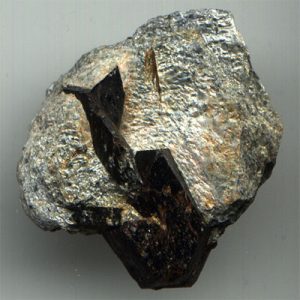Staurolite
Staurolite is extremely rare as a faceted gem. The mineral forms in interesting crystals shaped like crosses or X’s and are sometimes referred to as “Fairy Stone” or “Fairy Cross.” Staurolite is famous for these “twinned” crystals that forms two twin types; one that is nearly 90 degrees (like a cross) and one that is nearly 60 degrees (like an X). The 60 degree type is more common but the 90 degree type is the most sought after as a symbol of the Christian cross and as a good luck charm. Some rare specimens show both twin forms together and look like a six rayed star. Transparent material is rarely found and cut gems are typically small and very dark red. They lack fire but are prized for their rarity.
Most facetable material comes from Ardenella and Rubellita, Minas Gerais, Brazil; Liaoning Province, China; and Pizzo Forno and Alpe Piona, Ticino, Switzerland.
| Category: | Nesosilicate |
| Crystallography: | Monoclinic – Prismatic |
| Crystal Habit: | Commonly in prismatic crystals, typically rough, to 12 cm. |
| Twinning: | Commonly as 60º twins with [231] as twin plane, may be cyclic; less commonly as 90º cruciform twins with [031] as twin plane. |
| Cleavage: | [010] Distinct |
| Fracture: | Conchoidal |
| Tenacity: | Brittle |
| Hardness (Mohs): | 7.0 – 7.5 |
| Density: | 3.74 – 3.83 (g/cm3) |
| Luminescence: | None |
| Radioactivity: | Not Radioactive |
| Color: | Dark Reddish Brown to Blackish Brown, Yellowish Brown, rarely Blue |
| Transparency: | Transparent to Opaque |
| Luster: | Sub-Vitreous to Resinous |
| Refractive Index: | 1.736 – 1.762 Biaxial ( + ) |
| Birefringence: | 0.0090 – 0.0150 |
| Dispersion: | Weak; r > v |
| Pleochroism: | Visible; X = colorless, Y = pale yellow, Z = golden yellow |


